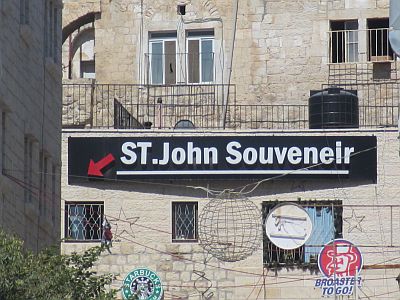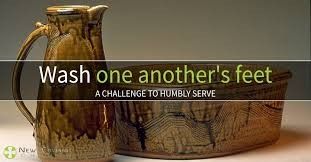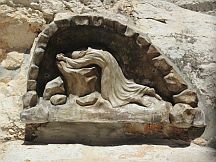Session Eight - The Gospel According to John
Author
John -the early Church writers confirmed this. The author was an eyewitness to the events in the gospel (1:14; 19:35; 21:24; his accounts are very detailed); he was probably one of the inner circle of three disciples (James, John, and Peter); he was among the first Mary told of the resurrection (20:1-10). But he must have been very young at the time of Jesus. Given that we believe he also wrote Revelation (circa 96AD), John would still have been around at the time of the fall of Jerusalem in 70AD.
The NT conveys initial images of John with a bad temper and quick to judge (Luke 9:49-50 and 51-56). Jesus called him a "son of thunder" (Boanerges), along with his brother James (Mark 3:17). James and John sought to be installed as Jesus' senior team (Mark 10:35-37). Not a promising start. However, over time John has been assumed the most likely disciple to be the man described in John as "the disciple whom Jesus loved". Real transformation had occurred; we will see this again in John's epistles. Church legend reported by Tertullian has John thrown into a cauldron of boiling oil (in an attempt to kill him), from which he escaped unharmed. Other legends exist.
Date of Composition
Biblical scholars believe that Gospel was composed around 80-90AD, after the deaths of the other first church leaders. Traditionally, Ephesus has been favoured as the place of composition, though many support a location in Syria, perhaps Antioch, while some have suggested other places, including Alexandria.


Location, Purpose and Audience
John is written for a Greek audience, but has references Jews would have understood, eg Messiah, temple rites, the attitude of the Jews to the Samaritans (even though John was obviously Jewish, as one of the sons of Zebedee; Capernaum was at a commercial crossroads). He explains Jewish feasts to his readers. John was a fisherman by trade, the brother of James, and a friend of Peter, does not focus on the Law the way Matthew does:
"For the law was given by Moses, but grace and truth came by Jesus Christ." (1:17).
John writes to prove that Jesus is the Creator and Christ, by citing a carefully chosen limited selection of his teachings, miracles and witnesses.
"... this is the way to have eternal life—to know you, the only true God, and Jesus Christ, the one you sent to earth" (17:3)
Themes and Theology
John portrays Jesus as the Son of God. The Gospel of John is the "Gospel of Belief", mixed (ironically) with early rejection of Jesus.
"He came into the very world he created, but the world didn't recognize him. He came to his own people, and even they rejected him. But to all who believed him and accepted him, he gave the right to become children of God." (1:11-12).
More than a teacher, rabbi, prophet, good man, historical figure, healer, deliverer.
Other great themes in John include: new birth, redemption; knowing God; counting the cost of discipleship, and the coming and role of the Holy Spirit.
Literary Style and Structure
John is a popular book. John 3:16 is the most quoted verse from the Bible.
The Gospel according to John is quite different in character from three "synoptic" gospels. It is highly literary and symbolic. It does not follow the same order or reproduce the same stories as the synoptic gospels. Of all the miracles performed by Jesus, John only choose a few, to demonstrate his point.
John omits a large amount of material found in the synoptic Gospels, including some important episodes such as the temptation of Jesus, His transfiguration, the calling and commissioning of the disciples, and the institution of the Lord's Supper. John mentions no examples of Jesus casting out demons. The Sermon on the Mount and the Lord's Prayer are not found in John. Nor is Jesus' ascension.

John includes a considerable amount of material not found in the synoptic Gospels. He has more information about John the Baptist than the synoptics. All the material in John 2—4, Jesus' early Galilean ministry, is not found in the synoptics. Visits of Jesus (as an adult) to Jerusalem before the passion week are mentioned in John but not found in the synoptics. The resurrection of Lazarus (John 11) is not mentioned in the synoptics either, nor is the extended Farewell Discourse of Jesus (13-17). Nicodemus and Joseph of Arimathea are only found in John.
John only mentions "the Kingdom" 5 times (compared with in a total of 121 times in Matthew, Mark and Luke combined); but "life" appears 36 time (compared with a total of 16 times in Matthew, Mark and Luke), and believe, or belief, appear 98 times.
John is considered to be the most "spiritual" record of the Gospel, and the most theological.
Jesus the Logos
"In the beginning was the Word [logos], and the Word was with God, and the Word was God. He was with God in the beginning. Through him all things were made; without him nothing was made that has been made. In him was life, and that life was the light of men. The light shines in the darkness, but the darkness has not understood] it. The Word became flesh and made his dwelling among us. We have seen his glory, the glory of the One and Only, who came from the Father, full of grace and truth." (John 1:1-5, 14 NIV)
Logos lit. = "word", "reason". Featured in the writings of many Greek philosophers. For Christians, Jesus is the eternal Word, the expression of the Father's character.
John does not start at Jesus' genealogies, or the nativity, but goes back much further. He proclaims Jesus as the preexistent and incarnate Word of God who has come in human flesh to reveal the Father to us.
Many religions rely on the written word, eg the Koran in Islam and the Vedas in Hinduism (containing hymns, incantations, and rituals from ancient India, the Vedas have also influenced Buddhism, Jainism, and Sikhism). By comparison, in Christianity the [logos] took on human flesh, came to earth and spoke to us personally (John 1:14).
The Claims of Christ
Jesus claimed to have a special relationship with God the Father -John 14:9-11; 16:28; 17:25; 20:21.
He made specific claims about Himself as the "I Am".
| John 6:51:"I am the living bread which came down from heaven. If anyone eats of this bread, he will live forever" |
| John 8:23: "And He said to them, 'You are from beneath; I am from above. You are of this world; I am not of this world' ". |
| John 8:12 (and 9:5): "Then Jesus spoke to them again, saying, "'I am the light of the world. He who follows Me shall not walk in darkness, but have the light of life'." |
| John 8:58 "Jesus said to them, 'Most assuredly, I say to you, before Abraham was, I AM'." The Jewish leaders recognized that Jesus was addressing Himself with an expression only Jehovah could use; "I AM, the Eternal/Self Existent One; the response God used in the Hebrew Bible (the Torah) when Moses asked for His name (Exodus 3:14). Therefore, they tried to stone Him - they knew what He was saying. |
| John 10:9: "I am the door. If anyone enters by Me, he will be saved, and will go in and out and find pasture." |
| John 10:11: "I am the good shepherd. The good shepherd gives His life for the sheep." |
| John 10:36: "do you say of Him whom the Father sanctified and sent into the world, 'You are blaspheming,' because I said, 'I am the Son of God'?' " |
| John 11:25: "Jesus said to her, 'I am the resurrection and the life. He who believes in Me, though he may die, he shall live'." |
| John 13:13: You call me 'Teacher' and 'Lord', and rightly so, for that is what I am. |
| John 14:6: "Jesus said to him, 'I am the way, the truth, and the life. No one comes to the Father except through Me'." |
| John 15:1: "I am the true vine, and My Father is the vinedresser." |
| John 19:2: "Therefore the chief priests of the Jews said to Pilate, "Do not write, 'The King of the Jews,' but, 'He said, "I am the King of the Jews'.'" |
Miracles in John
John's Gospel records nine miracles that show aspects of Jesus' authority
| | Miracle | Demonstrated
Jesus' Power Over |
|---|
| 1. | Turning water into wine - 2:11 | quality |
| 2. | Healing the nobleman's son - 4:46-54 | distance |
| 3. | Healing the lame man - 5:1-9 | time |
| 4. | Feeding of the 5,000 - 6:1-14 | quantity |
| 5. | Walking on water - 6:16-21 | natural law |
| 6. | Healing of the man born blind - 9:1-12 | time |
| 7. | Raising of Lazarus - 11:1-16 | death |
| 8. | Jesus' own resurrection - 20:1-9 | death, Satan |
| 9. | Miraculous catch of fish - 21:1-7 | God's creatures |
The purpose of John is expressed at the end of Chapter 20:
"Jesus did many other miraculous signs in the presence of his disciples, which are not recorded in this book. But these are written that you may believe that Jesus is the Christ, the Son of God, and that by believing you may have life in his name." (John 20:30-31, NIV)

Parables of Jesus recorded in John
John is full of symbolism: "'Look, the Lamb of God, who takes away the sin of the world!" (1:29).
John does not use the word "parable", however there are some clear analogies, especially:
- the new birth (3:1-8)
- water of life (4:1-26; 7:37-39)
- Jesus as the Good Shepherd (10:1-30)
- the vine and the branches (15: 1-17)
- the woman in childbirth - 16:21


The Holy Spirit in John
The Synoptic Gospels have little to say when considering the person and work of the Holy Spirit. In John, three chapters (14-16) teaching on the Holy Spirit's role in the life of the believer. The Holy Spirit was an essential part of Jesus' ministry. Not only was Jesus enlivened by the Spirit, Jesus also taught his disciples that the Holy Spirit would be an essential part of their ministry.
Jesus Witnesses:
- John the Baptist - 1:34
- Nathanael - 1:49
- Peter - 6:69
- Martha - 11:27
- Thomas - 20:28
- John - 20:31
The Passion in John - Chapters 18, 19
- triumphal entry into Jerusalem
- Jesus washes His disciples' feet
- the Last Supper
- Jesus predicts Peter's denial
- Jesus prays on the Mt of Olives
- betrayed and arrested
- Peter's denial
- trial before the Sanhedrin
- trial before Pilate
- crucifixion
- death
- burial and resurrection
Chapter 21 contains personal application.


For Reflection:
- Do you believe that Jesus is the Son of God?
- John the Baptist declared about Jesus "He must increase; I must decrease". Is this your attitude?
- How might we show servant leadership today that reflects Jesus washing his disciples' feet?
- "Love each other in the same way I have loved you." How can we practice this?
- "When you produce much fruit, you are my true disciples. This brings great glory to my Father." Are our lives (not just our activities or results focus) genuinely fruitful? Does our fruit come from relationship with Jesus? Does the fruit last?
- "If the world hates you, remember that it hated me first." Is this your perspective?
- Jesus is the Good Shepherd. Are you following him and leading others likewise?
- Do you ever find yourself comparing your life and journey with others? Instead, Jesus says, "As for you, follow me."







